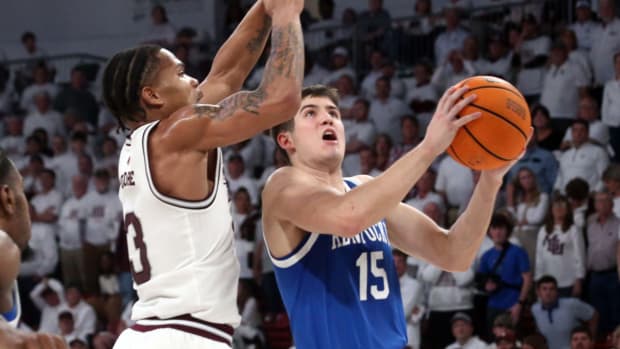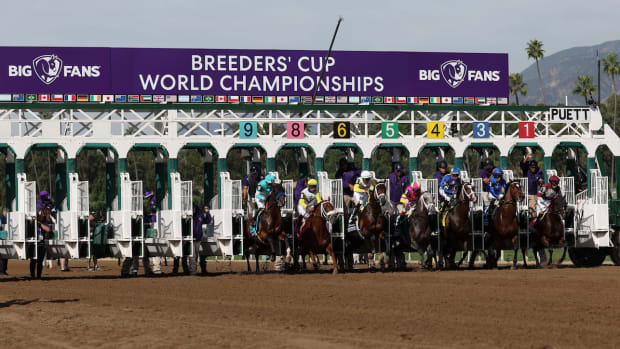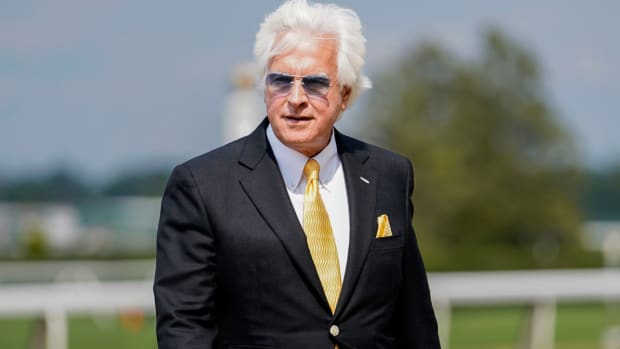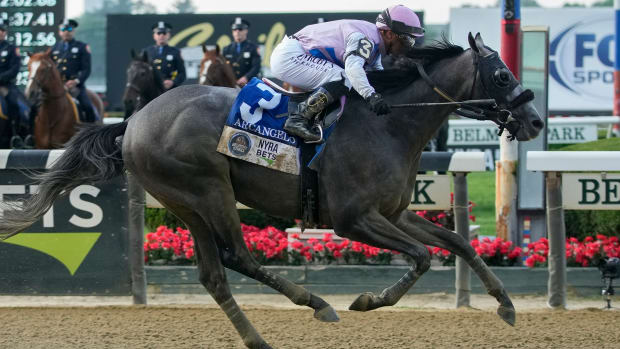Behind Kentucky Derby favorite Nyquist, a familiar team
When most of America last saw the horse racing team of trainer Doug O’Neill and owner Paul Reddam, it was at a hastily arranged press conference on the day before the 2012 Belmont Stakes. Reddam owned and O’Neill trained a 3-year-old chestnut colt named I’ll Have Another, who had won the Kentucky Derby and Preakness in that spring and arrived at Belmont Park with a chance to end the then 34-year drought between Triple Crown winners that American Pharoah would actually end three years later. That notorious drought had endured in every imaginable way, from the great Spectacular Bid (supposedly) stepping on a safety pin in his stall on the day of the Belmont in 1979 to Big Brown mysteriously slowing on the turn for home in 2008 and 10 other ways in between. But that humid Friday afternoon four years ago brought yet another one, the most surreal and most deflating of them all.
A microphone stand was placed outside a barn at the edge of a rubber pad where horses are bathed—and endlessly photographed, steaming—in the morning. Twenty feet away, media members lined up five-deep along a too-narrow stretch of white fencing and photographers climbed the fire escape on a facing cottage to document the moment. Reddam stepped to the microphone and spoke four sentences confirming what O’Neill had said in a radio interview three hours earlier: That I’ll Have Another had sustained a tendon injury and would not run in the Belmont. “I’m afraid that history is going to have to wait for another day,” said Reddam, in the last of those four sentences, before O’Neill spoke considerably longer. In a column that day for SI.com, I wrote, “It felt like an entire sport had been canceled.” And in that moment, it did.
What did American Pharoah’s Triple Crown mean for racing?
For O’Neill and Reddam, that day was the conclusion of five weeks that were both wildly euphoric and relentlessly bruising. Together they had reached the pinnacle of the racing game by winning the Derby, tacked on the Preakness and reached the doorstep of the Triple Crown as the 4–5 morning line favorite in the Belmont. But that was just half the story. As I’ll Have Another was running toward history, the racing industry was struggling to control the actions of rogue trainers who use illegal drugs to keep horses running fast, or simply just running. O’Neill had been punished a dozen times for drug-related violations in multiple states. He was cast in the media as an example of all that was wrong with the sport (and Reddam was criticized not only for employing O’Neill, but for once owning a company that sold subprime mortgages and founding CashCall, the company he still owns, which specializes in high-interest loans). It was a daily flogging in which a broad swath of media participated in a broad-strokes, agenda-driven piling on that abandoned fairness in the name of symbolic vigilance. For O’Neill the cusp of history turned out to also be the wrong place at the wrong time.
O’Neill remembers the low point. “A couple days before the Belmont, NBC hooked me up for an interview with Bob Costas,” says O’Neill. “And he says to me, ‘Do you know people call you Drug O’Neill?’ I’m like, ‘What?”’ (That nickname was commonly whispered in the back alleys of the sport.) This was after the New York Racing Association implemented a rule mandating that Belmont Stakes horses be placed in a detention barn 72 hours before the race, presumably to prevent O’Neill from performing his nefarious deeds (or more likely, to give the appearance of diligence and placate critics). The rule lasted one year.
Much as with Big Brown’s four years earlier (whose recidivist doping trainer, Rick Dutrow, was later banned for life), I’ll Have Another’s Triple Crown attempt was sullied by a parallel narrative. It wasn’t fun for anybody, least of all Reddam and O’Neill. A couple of days after the 2012 Derby, an ecstatic Reddam was alerted to an article about his success, but warned against reading the reader comments. “So of course I read the comments,” says Reddam. “It was really quite shocking to see all that venom out there. It was all a roller coaster ride. And some of that ride was very unpleasant.”
O’Neill says, “People patting you on the back. And kicking you in the nuts at the same time. We had fun in 2012, but I feel like I was unfairly beaten up. This year it’s different.”
This year O’Neill and Reddam are back in Kentucky, with an unbeaten colt named Nyquist, who will almost certainly be the favorite in the Derby. He has won all seven of his career starts, captured the Breeders Cup Juvenile race last Halloween and has won both of his starts this spring, the last on April 16, when he won the Florida Derby by 3 ½ lengths. This year’s Derby is considered largely inscrutable, with many flawed starters and little star power. Even the top half dozen horses seem to have major weaknesses. But no horse in the field has done more than Nyquist and no horse deserves more to be the favorite.
Two weeks ago I talked to O’Neill in the tack room of a barn at Keeneland Race Track in Lexington, where Nyquist was shipped after the Florida Derby and did most of his training for the Kentucky Derby. Four years after I’ll Have Another, O’Neill is much the same person who both celebrated and endured that experience. He is glib and occasionally irreverent (although more careful now), a 47-year-old, married father of two who was raised in Santa Monica, Calif., and still lives there. He was bald in 2012 and now he has wispy hair. “Like Steve Asmussen,” he said, running his fingers through his thin locks and invoking the name of another Derby trainer, one with a spectacular, thick mane of salt-and-pepper hair. A good horse hair joke, for a limited audience.
O’Neill would like to put 2012 forever behind him. “I try not to even look back,” he says. But that period remains implanted in the storyline. Sixteen days before the 2012 Belmont, O’Neill was given a 45-day suspension because one of his horses was found to have an elevated level of carbon dioxide after a race in 2010, which can indicate that the horse was “milkshaked” (that is, given a large dose of sodium bicarbonite, which helps buffer lactic acid and thus delay fatigue). Investigators found no evidence that the horse had been milkshaked, and O’Neill said then, and maintains now, that he has never milkshaked a horse. The numbers mandated the suspension, without attaching cause.
His explanation for his multiple violations prior to 2012 (and a higher-than-average rate of breakdowns) has changed little since then: He ran too many horses at too many tracks (often to help those tracks fill fields) and exercised too little oversight. “We ran a lot of horses at a lot of tracks and we got scattered around and got loosey-goosey,” says O’Neill. “A lot of what we did in those years, prior to 2012, was not in the best interests of our horses. That was our biggest problem.”
Derby 2016: 5 horses to watch in 142nd Kentucky Derby
happen again.”’
Now, when O’Neill ships a horse to a track, his team employs 24-hour security and disinfects the stall in which the horse is placed. At their home barn at Santa Anita Race Track, O’Neill has a security detail and surveillance cameras. O’Neill has never pointedly accused anyone of sabotaging his horses, but the subtext of his actions is clear. And, most important, he has not had a violation since that New York incident almost three years ago. “We’re more conscientious now, more attention to detail,” says O’Neill. “I’m very proud of where our program is at present. It’s been smooth sailing since that thing in New York.” With that, O’Neill reaches out and raps his knuckles on a wooden support beam.
Four years ago, I’ll Have Another came to the Kentucky Derby as the winner of two major California prep races: The Robert Lewis Stakes and the Santa Anita Derby, yet was disrespected by Derby bettors and let go at odds of 16–1, ninth choice in the 20-horse field. O’Neill scored big with a future book wager place in Nevada; he took a limo to the desert to collect. Nyquist, meanwhile, has never been longer than 8–1 odds. There’s no future book money to be had this time.
Like I’ll Have Another, Nyquist was selected for Reddam by O’Neill’s brother, Dennis, at a Florida sale of 2-year-olds. The colt took a circuitous route to that sale. As an 8-month-old weanling, the unnamed Nyquist was sold for $180,000. It was then sold again, as a yearling, 11 months later, in September of 2014 for $230,000 to Niall Brennan, an Irishman and highly respected Florida pinhooker. Brennan broke Nyquist and entered him last March in a sale of 2-year-olds at Gulfstream Park in Florida. Nyquist was from the first crop of foals sired by Uncle Mo, who was the presumptive favorite in the 2011 Kentucky Derby, but missed the race with an injury. A stallion’s first crop of foals comes with uncertainty, but Dennis O’Neill loved Nyquist. “Drop dead gorgeous, very correct,” says O’Neill. “It was just a matter of whether we could afford him.” O’Neill told Reddam that Nyquist would sell for $800,000 to $1 million, “but maybe he will fall through the cracks and we can get him for $600,000 or $700,000.” Reddam seldom pays that much for a horse, playing the game in the margins between claimers and sheikhs.
The SI Extra Newsletter Get the best of Sports Illustrated delivered right to your inbox
Subscribe
That entire Florida sale was significant for Reddam, who also buys yearlings in a partnership with pinhooker Ciaran Dunn with the intention of selling them for a profit at age two. One of those yearlings, a son of Eskendereya, was bought in 2014 for $85,000 and entered in Gulfstream Park sale. Dennis O’Neill told Reddam that the goal was to keep the Eskendereya colt and buy the Uncle Mo. But trainer Bob Baffert, bidding for Pandora Jewelry founder Michael Lund Peterson, bought the Eskendereya colt for $640,000, an enormous profit for Reddam. (Baffert, who trained American Pharoah, bid surreptitiously on the colt, because often his presence in an auction drives up prices. “I was hiding in the back, on the phone, giving my bids to somebody else,” says Baffert. “I didn’t want anybody to know it was me.”)
Reddam’s gain came with a caveat: Baffert took Reddam’s and Dunn’s Eskendereya colt and turned him into Mor Spirit, a dangerous grinder who finished second in both the San Felipe Stakes and Santa Anita Derby. With Baffert calling the shots and veteran Gary Stevens in the saddle, Mor Spirit will be among the top half choices in the Derby. Meaning: Reddam could come to Kentucky with the Derby favorite and lose to a horse that he sold. “You have to sell horses to make money, and Mor Spirit’s success is good for our pinhooking business,” says Reddam. On the other hand, he said, “It’s all a big poker game.”
Ten horses after Reddam lost Mor Spirit—again, at a profit of $555,000—he bought Nyquist. O’Neill’s prediction of a price approaching $1 million didn’t happen. “We got to $400,000 and the bidding just stopped,” says O’Neill. Brennan had set a reserve price of $399,000, which means that O’Neill was effectively the only bidder. “We were happy with the price,” says Brennan. “But we thought he would bring more.” There were rumors that some veterinarians had found a touch of unsoundness in Nyquist’s legs. Sales are like the NFL draft. O’Neill’s vet didn’t see it and neither did O’Neill. Brennan, who saw Nyquist every day for nearly a year, says, “He’s a supreme athlete, like a Kobe Bryant or Jerry Rice. People might say their vet turned him down for this or that. It’s all baloney.”
This much is true: In the 14 months since that day in Florida, Nyquist has not taken a step backward. Seven races, seven wins. Now he brings a familiar team back to Kentucky, four years later, all of them seeking the same result and a different public reaction. White hats, not black ones. “All year, it’s been a lot more fun, a lot easier,” says Dennis O’Neill. “Let’s hope it stays that way.”






